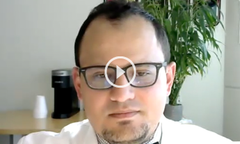
Considering 3-Year Follow-Up Data of Cilta-Cel in Multiple Myeloma
Samer A. Al’Hadidi, MD, discusses the follow-up data for ciltacabtagene autoleucel in patients with multiple myeloma.
Episodes in this series

Samer A. Al’Hadidi, MD, assistant professor in the Department of Internal Medicine — Division of Hematology and Oncology at UAMS Winthrop P. Rockefeller Cancer Institute in Little Rock, Arkansas, discusses the follow-up data for ciltacabtagene autoleucel (cilta-cel; Carvykti) in patients with multiple myeloma.
During a Case-Based Roundtable event, Al’Hadidi reviewed the 3-year follow-up data of CARTITUDE-4 trial (NCT04181827). Patients on the trial experienced superior progression-free survival (PFS), overall survival (OS), and duration of response with cilta-cel vs standard of care (SOC). Al’Hadidi also notes that there are still two-thirds of patients responding to cilta-cel compared with one-third with SOC.
The longer-term toxicities observed in the trial included higher risk of developing secondary malignances with cilta-cel, which is something oncologists tend to focus on, according to Al’Hadidi. Additionally, he discussed the real-world data showing that the 1-year PFS rate with cilta-cel was almost 70%.
TRANSCRIPTION:
0:10 | We discussed cilta-cel use and updated data that came from CARTITUDE-4 that [were] presented in the IMS [International Myeloma Society] meeting. [These] updated data [were] with the follow-up of almost 3 years. That showed 30-month PFS of 60% in cases of cilta-cel and around 26% in the SOC arm. Also, OS seemed to be better with the early use of cilta-cel with a 30-month OS of 76% compared [with] 64% in the SOC arm. With the longer follow-up, we also see longer data on response, and we have deeper responses with stringent CR being better with longer follow-up in cases of cilta-cel, as well as the 30-month duration of response, where two-thirds of patients who got cilta-cel are still responding, compared [with] around one-third of patients in the SOC arm.
1:06 | We also discussed data on adverse events to watch for with longer follow-up, including secondary malignancies. We focus in general in secondary hematologic malignancies, because we worry most about those sorts of cancers, and there was around 3.5% risk of developing secondary hematologic malignancies in cases of cilta-cel, compared [with] 0.5% in the SOC arm. We also discussed data on real-world use of cilta-cel now since it’s being used more often in daily practice. There were data on the 1-year PFS close to 70% in those patients treated in the real world.












































